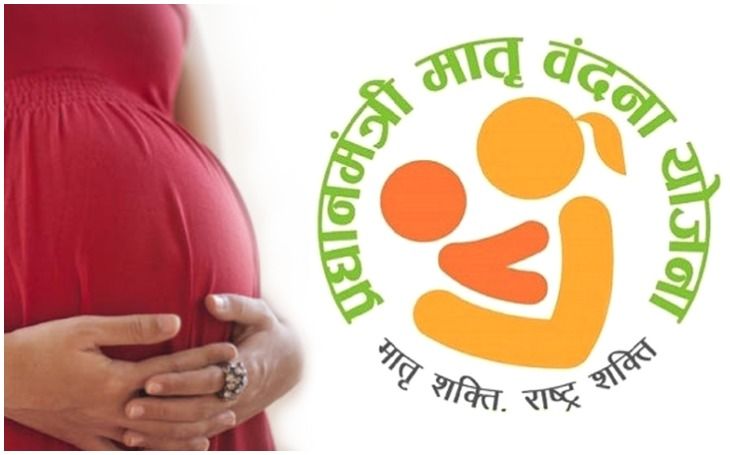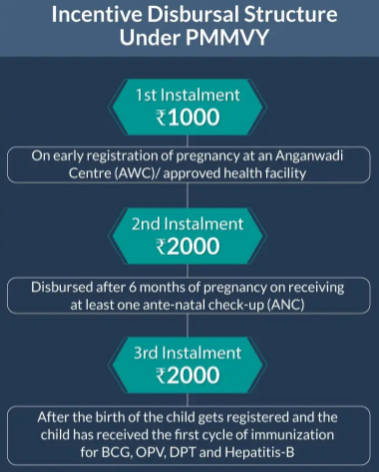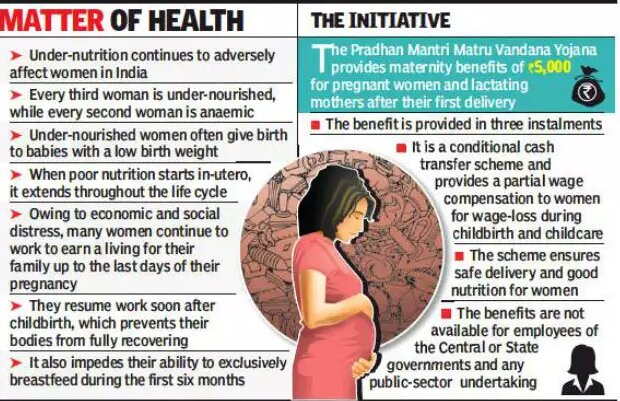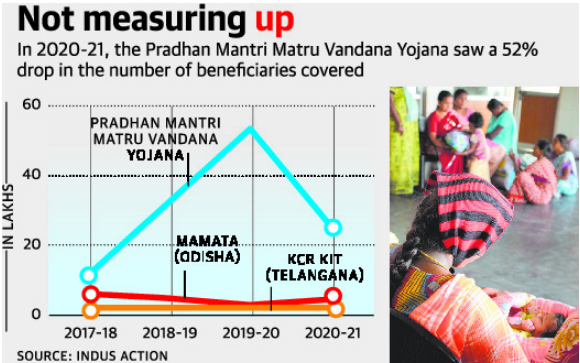Description

Disclaimer: Copyright infringement not intended.
Context
- The government’s recent announcement that the maternity benefit programme which provides Rs 5,000 for first child will be extended to cover the second child only if it is a girl has met with sharp criticism from activists who have demanded that it be universalized.
About
- Pradhan Mantri Matru Vandana Yojana (PMMVY) is a Maternity Benefit Programme that was launched in 2017.
Implementation
- It is a Centrally Sponsored Scheme implemented in all the districts of the country in accordance with the provision of the National Food Security Act, 2013.
Aim
- Providing partial compensation for the wage loss in terms of cash incentives so that the woman can take adequate res t before and after delivery of the first living child.
- The cash incentive provided would lead to improved health seeking behavior amongst the Pregnant Women and Lactating Mothers (PW& LM).
Target beneficiaries
- All Pregnant Women and Lactating Mothers, excluding those who are in regular employment with the Central Government or the State Governments or PSUs or those who are in receipt of similar benefits under any law for the time being in force.
- All eligible Pregnant Women and Lactating Mothers who have their pregnancy on or after 01.01.2017 for first child in family.
- The date and stage of pregnancy for a beneficiary is counted with respect to her Last Menstrual Period (LMP) date as mentioned in the Mother and Child Protection (MCP) card.

What Happens in Case of Miscarriage or Still Birth?
- In the case of a miscarriage or still birth, a beneficiary would be eligible to claim the remaining instalment(s) for a future pregnancy.
- For instance, if after receiving the 1st instalment of cash incentive, the beneficiary has a miscarriage, she would only be eligible for receiving 2nd and 3rd instalment for a future pregnancy.
What Happens in Case of Infant Mortality?
- In the case of infant mortality, a beneficiary would not be eligible for claiming benefits under the scheme, if she has already received all the instalments of the maternity benefit under PMMVY earlier.
Benefits under PMMVY
- Cash incentive of Rs 5000 in three instalmentse.

- The eligible beneficiaries would receive the incentive given under the Janani Suraksha Yojana (JSY) as well for Institutional delivery. Thus, PMMVY is combined with another scheme, Janani Suraksha Yojana, under which nearly Rs 1,000 is given for an institutional birth, so that a woman gets a total of Rs 6,000.
Registration under the Scheme
- The eligible women desirous of availing maternity benefits are required to register under the scheme at the Anganwadi Centre (AWC) / approved Health facility depending upon the implementing department for that particular State /UT.
Documents Required
- Duly filled Application Form 1A
- Copy of MCP card
- Copy of Identity Proof
- Copy of Bank/Post Office Account Passbook
- An undertaking/consent duly signed by the applicant and her husband,
Need of the Scheme
- Maternal health plays a vital role in enabling women to have a relatively easy and complication-free delivery.
- Back in 2015, India accounted for one-fifth of the global maternal deaths, which is an alarmingly large number. Health inequities and social hierarchies were the main reasons for this.
- A significantly large number of women, especially in rural India, suffer from anaemia and undernourishment. This, in turn, becomes a worrisome factor for healthy pregnancies and healthy births since undernourished mothers normally give birth to low birth weight babies, most times with complications.
- Due to various social factors, most women work until the last stages of pregnancy and soon after they deliver, which is far from healthy since their bodies do not get enough rest or time for recovery. It affects their ability to breastfeed the baby properly when that nourishment is crucial in the first six months.
- This is what adversely affects the health of the mother as well as the baby. Here lies the significance of PMMVY.

Objectives of PMMVY
- The mother getting adequate rest before and after delivery of the first living child is vital, which is why the PMMVY ensures providing cash compensation against any wage loss.
- Good healthcare and institutional care are essential to reduce the risk of the disease; hence the same is promoted.
- Promoting healthy behaviour among pregnant/lactating mothers by promoting good nutrition and feeding practices to reduce infant mortality rate and malnutrition.
Performance of PMMVY
- The performance of the scheme has been deficient, necessitating urgent need for improvement especially when the novel coronavirus pandemic has resulted in economic shocks for 260 lakh women who deliver on an average a child each year in India.
Issues:
Disbursal vs. Target Beneficiaries
- Since its inception, the PMMVY has covered 2.01 crore women nationally, disbursing a total amount of Rs 8,722 crore. But the annual estimate of the targeted beneficiaries by the Government of India has remained the same over the years.
Exclusion error
- While the estimated eligible population of pregnant and lactating mothers in India was 128.7 lakh for 2017-18 (as in a report by the Centre for Policy Research 2019-20), the target set by the Government was 51.70 lakh beneficiaries, which is only 40% of the eligible population.
- This means that we have an exclusion error of at least 60% since 2017, as the target has remained unchanged over the years.

Downfall in enrollment and disbursal
- Enrolment and disbursements under the scheme have witnessed a downward fall in the last two years, as in the data provided by the Ministry of Women and Child Development (WCD).
- In 2020-21, more than 50% of registered beneficiaries did not receive all three instalments and there was a 9% drop in enrolment under the scheme.
Reduced Budget
- Despite the Government’s continued emphasis on maternal and child health, the overall budget for women and child development was reduced by 20% for 2021-22.
Clubbing of allocation
- Budget allocation for the PMMVY has also been slashed as it has been clubbed under SAMARTHYA scheme.
- The overall budget of SAMARTHYA is Rs 2,522 crore, which is nearly equivalent to the budget of PMMVY alone in the previous financial years.
|
Mission and sub-missions
Mission Shakti envisages a unified citizen-centric lifecycle support for women through integrated care, safety, protection, rehabilitation and empowerment to unshackle women as they progress through various stages of their life.
Mission Shakti has two sub-schemes ‘Sambal’ and ‘Samarthya’.
While the “Sambal” sub-scheme is for safety and security of women, the “Samarthya” sub-scheme is for empowerment of women.
The Sambal sub-scheme consists of the existing scheme of One Stop Centres (OSC), Women Helplines (181-WHL) and BetiBachaoBetiPadhao (BBBP). Besides, a new component of Nari Adalats has been added as women’s collectives to promote and facilitate alternative dispute resolution and gender justice in society and within families.
The “Samarthya'' sub scheme is for empowerment of women, consisting of existing schemes of Ujjwala, SwadharGreh and Working Women Hostel. In addition, the National Creche Scheme for children of working mothers and the Pradhan Mantri Matru Vandana Yojana (PMMVY), which have been under the Umbrella ICDS Scheme till now, are also subsumed in ‘Samarthya’.
|
States as role models
- States such as Odisha, Telangana and Tamil Nadu, respectively, chose to implement State-specific schemes for maternity benefits:
- Odisha: MAMATA (2011) or the maternity entitlement scheme. Odisha’s MAMATA, has been offering a conditional cash transfer of Rs 5,000 as maternity benefit for up to two live births for more than a decade now. In a comparative analysis between the PMMVY and MAMATA for 2020-21, the PMMVY shows poor performance with a 52% drop in the number of beneficiaries covered while MAMATA showcased a 57% increase in women who received all the instalments. The scheme stands as a testament to an inclusive and efficient implementation of the maternity benefit programme, thereby serving as promising evidence for the Centre to improve the PMMVY in line with the Odisha government Scheme.
- Telangana: KCR Kit 2017: After deliver, the mother is provided with the KCR kit. The kit consists of 16 items that are essential to keep the new born clean and hygienic. The kit supplies would suffice the needs of the baby for three months. The kit has diapers, napkins, toys, mosquito nets, baby powder, baby oil, baby soaps, and clothes. It was launched in 2017 by the Chief Minister K Chandrasekar Rao. In 2017, the State Government of Telangana allocated Rs 605 crores for the scheme.
- Tamil Nadu: Launched in the year 1987 with the avowed aim to reduce IMR and MMR. Muthulakshmi Reddy Maternity Benefit Scheme (MRMBS) with relatively increased coverage and higher maternity benefits. Under this, Rs.18, 000/- is payable in five installments for all eligible mothers under MRMBS.
Way Ahead
Include Second live birth
- Extend the maternity benefit under the PMMVY to the second live birth.
- The predecessor scheme, the Indira Gandhi Matritva Sahyog Yojana was applicable for two live births.
- Of the total live births in India, 49.5% comprises first-order births and 29.9% are second-order births, as per Sample Registration Survey 2018.
- It is imperative to include second live birth under the maternity benefit cover particularly for women in the unorganised sector who are more vulnerable to economic shocks and nutrition loss for all child births.
|
Possible extension to second child
· The Centre is likely to soon extend its flagship programme — Pradhan Mantri Matru Vandana Yojana (PMMVY) — currently applicable to eligible pregnant women and lactating mothers for the first child in the family to the second one — only if the child born is a girl.
· The move is aimed at discouraging pre-birth sex selection
· Besides this in a signficant move written consent and the Aadhaar of husband will not be a mandatory criteria in the modified guidelines of PMMVY in order to facilitate inclusion of single mother and abandoned mother.
|
Increase in maternity benefit amount
- There must be an increase in the maternity benefit amount. Since the primary objective of the PMMVY is to provide partial wage compensation, we need to revisit the maternity benefit amount offered under the scheme.
- Most women continue to work during and post-pregnancy since they cannot afford to lose wages; additionally, they also spend on out-of-pocket expenses during pregnancy.
- The current entitlement of Rs 5,000 provided over one year amounts to one month’s wage loss (as per the Mahatma Gandhi National Rural Employment Guarantee Act wage rate of Rs 202).
- In line with the Maternity Benefit Act, 1961 which mandates 12 weeks of maternity leave for women with two or more children, pregnant and lactating mothers should receive 12 weeks of wage compensation amounting to Rs 15,000.
Address implementation gaps
- Eliminate correction queues. The implementation gaps in the PMMVY scheme lead to reduced coverage.
- These gaps stem from a lack of awareness within targeted beneficiaries and process level challenges.
Simplification of the process
- The current registration form requires a mother and child protection (MPC) card, husband’s Aadhaar card, bank passbook and registration form for each of the three instalments, resulting in delayed, rejected or pending applications.
- A simplification of the process can result in increased registration of beneficiaries.
Final Thoughts
- To fulfill India’s commitment towards the Sustainable Development Goal of improving maternal health, an ambitious Prime Minister’s Overarching Scheme for Holistic Nourishment (POSHAN) Abhiyan and a national maternity benefit scheme are promising initiatives by the Centre.
- Targets can be achieved only if we revisit the design and implementation of this scheme, drawing lessons from States such as Odisha which are successfully prioritising maternal health and nutrition in a pragmatic manner.
https://epaper.thehindu.com/Home/ShareArticle?OrgId=GRD9FMPHB.1&imageview=0
https://www.thehindu.com/opinion/op-ed/state-schemes-can-cast-a-lifeline-to-this-welfare-plan/article38094862.ece














